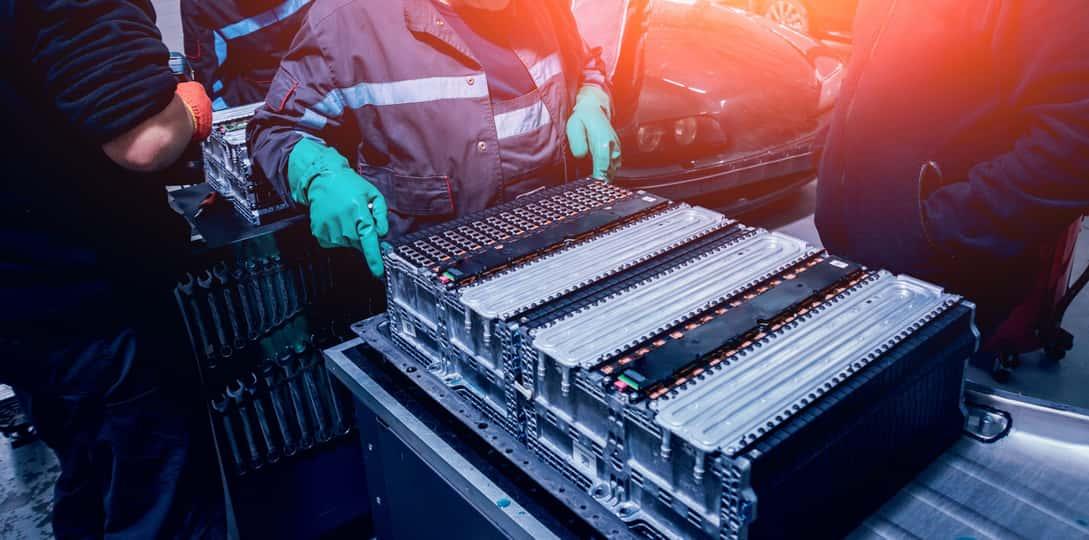California-based development-stage company QuantumScape Corporation (QS - Get Rating) develops and commercializes solid-state lithium-metal batteries for electric vehicles (EVs) and other applications. Panasonic Corporation (PCRFY - Get Rating) is a Japan-based electronics company that operates through four segments: Appliance; Eco Solutions; Connected Solutions; and Automotive and Industrial Systems. Its offerings include automotive-use batteries, refrigerators, and industrial motors and sensors.
The production of EVs continues to be negatively impacted by a global semiconductor shortage, which is in turn negatively affecting the demand for EV batteries. However, the EV battery market is expected to grow exponentially as increasing climate change concerns eventually lead to EVs domination of the automotive market. Indeed, according to a Fortune Business Insights report, the global EV battery market is expected to reach $82.20 billion by 2027, growing at a 6.65% CAGR. Furthermore, President Biden’s proposed infrastructure plan includes $7.5 billion for EV charging stations. So, EV battery stocks QS and PCRFY could benefit as a result.
PCRFY’s stock has gained 6% in price year-to-date, while QS lost 71.6%. Also, PCRFY’s 5.7% gains over the past three months compare to QS’ 22.6% loss. Moreover, in terms of the past month’s performance, PCRFY is the clear winner with 3.4% gains versus QS’ 4.3% loss.
But which of these two stocks is a better buy now? Let’s find out.
Click here to checkout our Electric Vehicle Industry Report for 2021
Latest Developments
A class-action lawsuit was filed against QS recently on behalf of purchasers of its securities between November 27, 2020, and December 31, 2020. It is alleged that the company had made false and/or misleading statements and/or failed to disclose that its purported success related to its solid-state battery power, battery life, and energy density were significantly overstated, among other allegations.
On April 23, PCRFY announced that it has agreed to acquire Blue Yonder, the leading end-to-end digital fulfillment platform provider. PCRFY’s CEO, Yuki Kusumi, said, “By merging the two companies, we would like to realize a world where waste is autonomously eliminated from all supply chain operations, and the cycle of sustainable improvement continues.”
Recent Financial Results
QS’ net income for the second quarter, ended June 30, 2021, came in at $80.99 million, versus a $13.95 million loss in the prior-year period. However, the company’s loss from operations increased 248.8% year-over-year to $49.62 million, while its loss per share came in at $0.12, up 100% year-over-year.
For its fiscal first quarter, ended June 30, 2021, PCRFY’s net sales increased 28.8% year-over-year to ¥1.79 trillion ($16.24 billion). The company’s operating profit came in at ¥104.40 billion ($947.12 million), representing a 2,647.4% year-over-year rise. Its net income came in at ¥81.20 billion ($736.65 million) versus a loss of ¥6.90 billion ($62.60 million) in the prior-year period. Also, PCRFY’s EPS was ¥32.79 ($0.30) compared to a ¥4.21 ($0.04) loss in the year-ago period.
Expected Financial Performance
QS’ EPS is expected to remain negative in its fiscal years 2021 and 2022. In contrast, analysts expect PCRFY’s revenue to increase 3.1% in its fiscal year 2022 and 3.9% in fiscal 2023. The company’s EPS is expected to grow 31.3% in the current year and 33% next year.
Profitability
PCRFY is more profitable with a 5.75% ROTC compared to QS’ negative value. Moreover, PCRFY’s ROE and ROA of 10.88% and 3.54%, respectively, compare with QS’ negative values.
So, PCRFY is the more profitable stock.
Valuation
In terms of trailing-12-month Price-to-Book, QS is currently trading at 6.61x, which is significantly higher than PCRFY’s 1.20x.
POWR Ratings
QS has an overall F rating, which equates to Strong Sell in our proprietary POWR Ratings system. In comparison, PCRFY has an overall B rating, which translates to Buy. The POWR Ratings are calculated considering 118 distinct factors, with each factor weighted to an optimal degree.
QS has an F grade for Value, which is in sync with its 6.06x trailing-12-month P/B, which is 85.3% higher than the 3.27x industry average. PCRFY, on the other hand, has an A grade for Value, which is consistent with its 1.20x trailing-12-month P/B, which is 63.3% lower than the 3.27x industry average. Also, PCRFY has a B grade for Stability, while QS has a Stability grade of D.
Of the 67 stocks in the Auto Parts industry, QS is ranked #66, while PCRFY is ranked #11 of 45 stocks in the Technology – Hardware industry.
Beyond what we’ve stated above, we have also rated the stocks for Growth, Momentum, Sentiment, and Quality. Click here to view all the QS ratings. Also, get all the PCRFY ratings here.
The Winner
Amid rising climate change concerns, the demand for EV batteries is expected to increase significantly. While PCRFY’s first-quarter profit soared 27 times on robust battery demand, QS has yet to generate revenue. Moreover, PCRFY’s better growth prospects and higher profitability make it a better buy here.
Our research shows that odds of success increase when one invests in stocks with an Overall Rating of Strong Buy or Buy. View all the top-rated stocks in the Auto Parts industry here. Also, click here to see all the other top-rated stocks in the Technology – Hardware industry.
Click here to checkout our Electric Vehicle Industry Report for 2021
Want More Great Investing Ideas?
PCRFY shares were unchanged in premarket trading Tuesday. Year-to-date, PCRFY has gained 6.59%, versus a 19.07% rise in the benchmark S&P 500 index during the same period.
About the Author: Manisha Chatterjee

Since she was young, Manisha has had a strong interest in the stock market. She majored in Economics in college and has a passion for writing, which has led to her career as a research analyst. More...
More Resources for the Stocks in this Article
| Ticker | POWR Rating | Industry Rank | Rank in Industry |
| PCRFY | Get Rating | Get Rating | Get Rating |
| QS | Get Rating | Get Rating | Get Rating |






